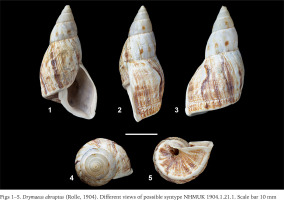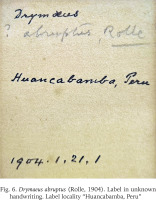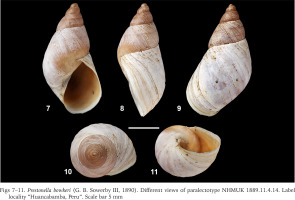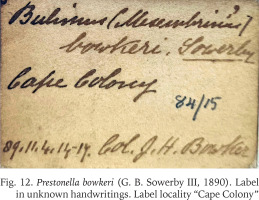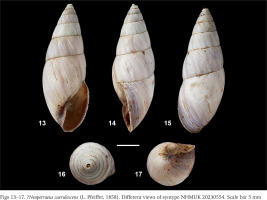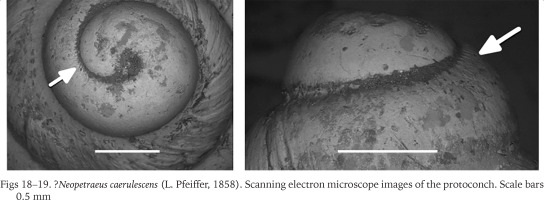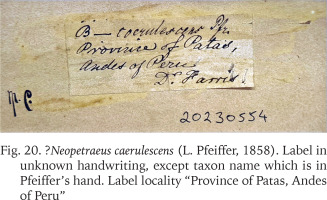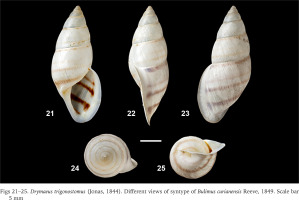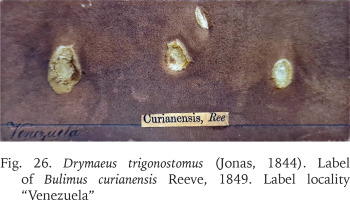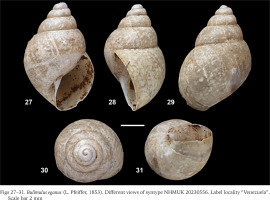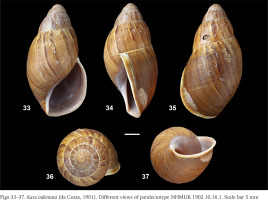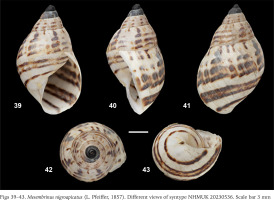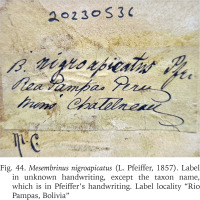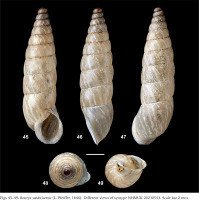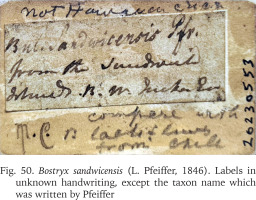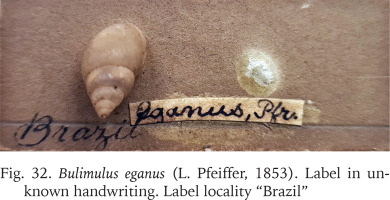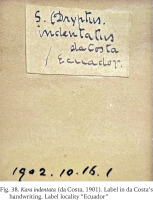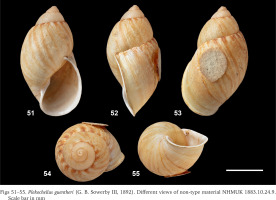APPENDIX 1
List of taxa for which Orthalicoidea types are extant, or discussed, in the NHMUK collection.
Remarks. This list has been compiled from 2011: Amphibulimidae (Breure & Ablett 2011); 2012: Bothriembryontidae and Odontostomidae (Breure & Ablett 2012); 2014: Bulimulidae (Breure & Ablett 2014); 2015: Megaspiridae, Orthalicidae, and Simpulopsidae (Breure & Ablett 2015); 2024: Appendix (this paper). The numbers following the taxa author and data refer to the Breure and Ablett publications mentioned above and the page number of the article they are cited on.
A black diamond (♦) indicates a nomen inquirendum, an asterisk (*) denotes taxa now excluded from the Orthalicoidea. A pilcrow sign (¶) is type material not located but previously known to be present; with a dagger (†) taxa are indicated for which type material was expected but not found, and a white square (□) is used for taxa of which material is not (or no longer) considered to be type specimens. Finally, a black square (■) indicates taxa treated otherwise in the text, e.g. as junior or senior synonym.
abruptus Rolle, 1904: 2014, 7; 2024, 28
abscissus L. Pfeiffer, 1855: 2014, 8
abyssorum d’Orbigny, 1835: 2014, 9; ■2014, 91
acalles L. Pfeiffer, 1853: 2014, 9
acervatus L. Pfeiffer, 1857: 2014, 10
achatellinus Forbes, 1850: 2014, 10
achilles L. Pfeiffer, 1853: 2015, 21
acuminatus S. I. da Costa, 1906: 2014, 11
adamsonii J. E. Gray, 1834: 2015, 57†
adoptus Reeve, 1849: 2011, 14
aenea L. Pfeiffer, 1861: 2015, 21
aequatorianus E. A. Smith, 1877: 2014, 11
aequatorius L. Pfeiffer, 1853: 2014, 11
aestivus L. Pfeiffer, 1857: 2014, 12
affinis Broderip in Broderip et G. B. Sowerby I, 1832: 2014, 12
agueroi Weyrauch, 1960: 2014, 13
aileenae Breure, 1978: 2014, 13
alauda Hupé, 1857: ■2014, 193
alba Crosse, 1874: 2012, 5
alba G. B. Sowerby I in J. E. Gray et G. B. Sowerby I, 1839: 2015, 57†
alabastrinus S. I. da Costa, 1906: 2014, 14
albemarlensis Dall, 1917: 2014, 14
albicans Broderip in Broderip et G. B. Sowerby I, 1832: 2014, 15
albicolor Morelet, 1863: 2014, 15
albolabiatus E. A. Smith, 1877: 2014, 16
albus G. B. Sowerby I, 1833: 2014, 16
alexander Crosse, 1855: ■2012, 27
altoperuvianus Reeve, 1849: 2014, 17
alutaceus Reeve, 1849: 2015, 22
amandus L. Pfeiffer, 1855: 2014, 17
ambagiosus Suter, 1906: ■2012, 32
ambustus Reeve, 1849: 2014, 18; ■2014, 41
andicola L. Pfeiffer, 1847: 2014, 18
andoicus Morelet, 1863: 2014, 18
angasianus L. Pfeiffer, 1864: 2012, 5
angrandianus Pilsbry, 1897♦: ■2014, 164
angustus S. I. da Costa, 1906: 2014, 19
anthisanensis L. Pfeiffer, 1853: 2014, 19; ■2014, 186
antioquensis L. Pfeiffer, 1855: 2014, 20
apertus L. Pfeiffer, 1855: 2014, 20
apicepunctata Preston, 1914: 2014, 21
apiculatus J. E. Gray, 1834: 2014, 21
apodemeta d’Orbigny, 1835: 2014, 22; ■2014, 148
appendiculata L. Pfeiffer, 1847: 2011, 15
approximata Fulton, 1896: 2015, 22
aquilus Reeve, 1848: 2014, 22
arcuatostriatus L. Pfeiffer, 1855: 2014, 23
ascendens L. Pfeiffer, 1853: 2015, 23
asopeus Gassies, 1871: 2012, 6
atacamensis L. Pfeiffer, 1856: 2014, 23
atahualpa H. Dohrn, 1863: 2014, 24
attenuatus L. Pfeiffer, 1853: 2014, 24
atramentaria L. Pfeiffer, 1855: 2015, 57†
aulacostylus L. Pfeiffer, 1853: 2015, 57†
aureolus Guppy, 1866: 2014, 25
aurifluus L. Pfeiffer, 1857: 2014, 25
auriformis S. I. da Costa, 1904: 2011, 16
auris L. Pfeiffer, 1866: 2014, 26
aurissciuri Guppy, 1866: 2011, 16
backhuysi Delsaerdt, 2010: 2012, 6
badius G. B. Sowerby I, 1835: 2014, 26
bairdii Reeve, 1848: 2012, 6
balsanus Morelet, 1863: 2014, 27
baranguillanus L. Pfeiffer, 1853: ■2014, 20; 2014, 27
barbadensis L. Pfeiffer, 1853: 2014, 28
baroni (Helix) Fulton, 1896: 2014, 28
baroni (Bulimulus) Fulton, 1897: 2014, 29
bartletti H. Adams, 1867: 2014, 29
bellus S. I. da Costa, 1906: 2014, 30
bensoni Reeve, 1849: 2015, 23
bicolor G. B. Sowerby I, 1835: ■2014, 27; 2014, 30; ■2014, 155
bifulguratus Reeve, 1849: 2015, 24
bilabiatus Broderip et G. B. Sowerby I, 1829: 2015, 57†
bilineatus G. B. Sowerby I, 1833: 2015, 57†
binneyanus L. Pfeiffer, 1857: 2014, 31
binominis E. A. Smith, 1895: ■2014, 106
bivittatus G. B. Sowerby I, 1833: ■2014, 77; 2015, 57†
blainvilleanus L. Pfeiffer, 1848: 2015, 57†
blandi Pilsbry, 1897: ■2014, 30
bogotensis L. Pfeiffer, 1855: 2014, 31
bolivarii d’Orbigny, 1835: 2014, 32
bolivianus L. Pfeiffer, 1846: 2014, 32
bolivianus Reeve, 1848: 2015, 57†
bonariensis Rafinesque, 1833: ■2014, 124
boucardi S. I. da Costa, 1907: 2014, 33
boucardi L. Pfeiffer, 1860: 2015, 24
bourcieri L. Pfeiffer, 1853: 2014, 33
bowkeri G. B. Sowerby III, 1890: 2012, 7; 2024, 29
brachysoma d’Orbigny, 1835: 2014, 34
brazieri Angas, 1871: 2012, 7
brephoides d’Orbigny, 1835: 2015, 25
broadwayi E. A. Smith, 1896: 2014, 34
broderipii G. B. Sowerby I, 1832: 2012, 8; ■2012, 16; ■2012, 17; ■2012, 35; ■2012, 43
bruggeni Breure, 1978: 2011, 17
brunneum Verdcourt, 1991: 2012, 8
buckleyi Higgins, 1872: 2015, 25
buckleyi G. B. Sowerby III, 1895: 2014, 35
bugabensis E. von Martens, 1893: 2014, 35
bulbulus Gassies, 1871: 2012, 9
cacticolus Reeve, 1849: 2014, 36
cactivorus Broderip in Broderip et G. B. Sowerby I 1832: ■2014, 133; 2015, 57†
cactorum d’Orbigny, 1835: 2014, 36
caerulescens L. Pfeiffer, 1858: 2024, 30
caledonicus Petit de la Saussaye, 1845: ■2012, 16
californicus Reeve, 1848: 2014, 37
caliginosus Reeve, 1849: 2014, 37
calus E. A. Smith, 1891: 2012, 9
canaliculatus L. Pfeiffer, 1845: 2014, 37
cancellata S. I. da Costa, 1906: 2014, 38
cantatus Reeve, 1848: 2015, 57†
cardinalis L. Pfeiffer, 1853: 2015, 57†
carinatum L. Pfeiffer, 1853: 2012, 10
castaneostrigatus S. I. da Costa, 1906: 2014, 38
castaneus L. Pfeiffer, 1845: 2011, 17
castelnaui L. Pfeiffer, 1857: 2015, 57†
castrensis L. Pfeiffer, 1847: 2015, 57†
castus L. Pfeiffer, 1847: 2014, 39
catharinae L. Pfeiffer, 1857: 2012, 10
cathcartiae Reeve, 1848: 2011, 17
catlowiae L. Pfeiffer, 1853: 2014, 39
caucaensis S. I. da Costa, 1898: 2014, 40
ceratacme L. Pfeiffer, 1855: 2014, 40
cercicola Morelet 1863: 2014, 40
chacoensis Preston, 1907: 2015, 57†
chamaeleon L. Pfeiffer, 1855: 2014, 41
chamayensis Weyrauch, 1967: 2014, 41
championi E. von Martens, 1893: 2014, 42
charpentieri L. Pfeiffer, 1850: 2012, 10
chemnitzioides Forbes, 1850: 2014, 42
chiletensis Weyrauch, 1967: 2014, 43
chimborasensis Reeve, 1848: 2014, 43
chiriquensis S. I. da Costa, 1901: 2014, 43
chrysostoma S. Moricand, 1836: ■2014, 190
cinereus Reeve, 1849: 2014, 44
citrinovitrea S. Moricand, 1836: ■2015, 56
citronellus Angas, 1879: 2014, 44
clarus L. Pfeiffer, 1857: 2014, 45
clathratus L. Pfeiffer, 1858: 2014, 45
clouei L. Pfeiffer, 1857: 2015, 26
coagulatus Reeve, 1849: 2014, 46
coarctatus L. Pfeiffer, 1845: 2014, 46
coerulescens L. Pfeiffer, 1858: 2015, 57†; 2024, 30
coloratus Nyst, 1845: ■2011, 23
columbianus Lea, 1838: ■2014, 84; ■2014, 86
columbiensis L. Pfeiffer, 1855: 2014, 47
columellaris Reeve, 1849: 2015, 57†
compactus Fulton, 1902: 2014, 47
confinus Reeve, 1850: 2015, 57†
confluens L. Pfeiffer, 1855: 2014, 48
confusus Reeve, 1848: 2014, 48
conicus S. I. da Costa, 1907: 2014, 49
coniformis L. Pfeiffer, 1847: 2015, 57†
consimilis Reeve, 1848: 2015, 26
conspersus G. B. Sowerby I, 1833: 2014, 49
constrictus L. Pfeiffer, 1841: ■2015, 33
constrictus Reeve, 1848: 2015, 58†
contortuplicatus Reeve, 1850: 2015, 58†
convexus L. Pfeiffer, 1855: 2014, 50; ■2014, 153
coquimbensis Broderip in Broderip et G. B. Sowerby I 1832: 2015, 58†
cora d’Orbigny, 1835: 2014, 50
corderoi Klappenbach, 1958: 2012, 11
coriaceus L. Pfeiffer, 1857: 2014, 51
corneus G. B. Sowerby I, 1833: ■2014, 135; 2015, 58†
corpulentus Gassies, 1871: 2012, 11
corrugatus Guppy, 1866: 2015, 26
corrugatus King in King et Broderip 1831: 2015, 58†
corticosus G. B. Sowerby III, 1895: 2011, 18
costatus L. Pfeiffer, 1848: 2012, 12
costatus Weyrauch, 1960: 2014, 51
costifer Weyrauch, 1960: 2014, 51
cotopaxiensis L. Pfeiffer, 1853: 2014, 52
coturnix G. B. Sowerby I, 1832: 2012, 12
crassilabrum Garrett, 1872: 2012, 12
crepundia d’Orbigny, 1835: 2014, 52
cretaceus L. Pfeiffer, 1855: ■2014, 29; 2014, 53
crichtoni Broderip, 1836: 2014, 54; ■2014, 93
culminea d’Orbigny, 1835: ■2014, 49; 2014, 54; ■2014, 101; ■2014, 111
cumingi L. Pfeiffer, 1861: 2015, 27
cumingii ‘Newcomb’ L. Pfeiffer, 1849: 2012, 13
cuninculinsulae Cox, 1872: 2012, 13
curianensis Reeve, 1849: 2015, 58†; 2024, 30
curtus Reibisch, 1892: 2014, 55
cuticula L. Pfeiffer, 1855: 2014, 55
cuzcoensis Reeve, 1849: 2014, 56
cylindricus Fulton, 1907: 2012, 14
S. I. da Costae G. B. Sowerby III, 1892: 2014, 56
darwini L. Pfeiffer, 1846: 2014, 56
dealbatus Say, 1821: ■2014, 110; ■2014, 165
deburghiae Reeve, 1859: 2015, 28; ■2015, 31
decoloratus G. B. Sowerby I 1833: 2015, 58†
decussata L. Pfeiffer, 1856: 2015, 28
decussatus Reeve, 1849: 2014, 57; ■2014, 130
dejectus Fulton, 1907: ♦2015, 54
delumbis Reeve, 1849: 2014, 57
demerarensis L. Pfeiffer, 1861: 2015, 29
demotus Reeve, 1850: 2014, 58
denickei J. E. Gray, 1852: 2014, 58
dennisoni Reeve, 1848: ¶2015, 55
dentata W. Wood, 1828: 2012, 14
dentritis Morelet, 1863: 2014, 59
depictus Reeve, 1849: 2014, 59
depstus Reeve, 1849: 2014, 60
derelictus Broderip, 1832: 2014, 60
deshayesi L. Pfeiffer, 1845: 2014, 61
devians H. Dohrn, 1863: 2014, 61
dillwynianus L. Pfeiffer, 1853: 2011, 18
discrepans G. B. Sowerby I, 1833: 2014, 62
dissimulans Preston, 1909: 2011, 19
doliarius S. I. da Costa, 1898: 2011, 19
dombeyanus ‘Férussac’ L. Pfeiffer, 1846: 2014, 62
draparnaudi L. Pfeiffer, 1847: 2015, 58†
droueti L. Pfeiffer, 1857: 2015, 58†
dubius L. Pfeiffer, 1853: 2014, 62
dukinfieldi Melvill, 1900 : ♦2014, 63
dunkeri L. Pfeiffer, 1846: 2014, 64
durangoanus E. von Martens, 1893: 2014, 64
dutaillyi L. Pfeiffer, 1857: 2014, 65
dux L. Pfeiffer, 1861: 2012, 15
dysoni L. Pfeiffer, 1846: 2014, 65
eddystonensis L. Pfeiffer, 1855: 2012, 15
edwardsi Morelet, 1863: 2014, 65
edwardsianus Gassies, 1863: 2012, 16
effeminatus Reeve, 1848: 2014, 66
eganus L. Pfeiffer, 1853: 2015, 58†; 2024, 32
elaeodes L. Pfeiffer, 1853: 2011, 46
elata Gould, 1847: 2015, 29
electrum Reeve, 1848: 2014, 66
elegans L. Pfeiffer, 1842: 2012, 16
elongata d’Orbigny, 1837: 2012, 17
elongatus Röding, 1789: ■2014, 22
elsteri S. I. da Costa, 1901: 2014, 67
emaciatus Morelet, 1863: 2014, 67
emeus Say, 1830: ■2014, 92
ephippium Ancey, 1904: 2015, 30
episcopalis L. Pfeiffer, 1855: 2011, 20
erectus Reeve 1849: 2014, 68
eros Angas, 1878: 2011, 20
erosus Broderip in Broderip et G. B. Sowerby I, 1832: 2014, 68
erubescens L. Pfeiffer, 1847: 2014, 69
erythrostoma G. B. Sowerby I, 1833: 2015, 58†
eschariferus G. B. Sowerby I, 1838: 2014, 69
euryomphalus Jonas, 1844: ■2011, 27
excoriatus L. Pfeiffer, 1855: 2014, 70
exornatus Reeve, 1849: 2014, 70
exoticus S. I. da Costa, 1901: 2014, 70
expansus L. Pfeiffer, 1848: ■2014, 177
expatriatus Preston, 1909: 2014, 71
fabrefactus Reeve, 1848: 2014, 71
falcicula Gassies, 1871: 2012, 17
fallax L. Pfeiffer, 1853: 2014, 72
farrisi L. Pfeiffer, 1858: 2014, 72
felix L. Pfeiffer, 1862: 2014, 73
fenestratus L. Pfeiffer, 1846: 2014, 73
fenestrellus E. von Martens, 1864: ■2014, 82
feriatus Reeve, 1848: 2014, 74
fernandezae Weyrauch, 1958: 2014, 74
ferrugineus Reeve, 1849: 2014, 75
fibratus Martyn, 1784: ■2012, 6; ■2012, 7; ■2012, 8; ■2012, 17; ■2012, 30; ■2012, 41
fidustus Reeve, 1849: 2014, 75
filaris L. Pfeiffer, 1853: 2014, 76
flavescens King in King et Broderip, 1831: 2015, 58†
flavidulus E. A. Smith, 1877: 2014, 76
flexilabris L. Pfeiffer, 1853: 2014, 76
flexuosus L. Pfeiffer, 1853: 2014, 77
floridanus L. Pfeiffer, 1857: 2014, 77
fontainii d’Orbigny, 1838: 2014, 78
fourmiersi d’Orbigny, 1837: 2014, 78
foveolatus Reeve, 1849: 2015, 30
foxi Clench, 1950: 2012, 18
fraseri L. Pfeiffer, 1858: 2015, 31
fucatus Reeve, 1849: 2014, 79
fuligineus L. Pfeiffer, 1853: 2012, 18
funckii Nyst, 1843: ■2011, 14
fuscagula d’Orbigny, 1837: 2012, 19
fuscobasis E. A. Smith, 1877: 2014, 79
fuscus Guilding, 1828: ■2014, 28
fusiformis Menke, 1828: ■2012, 10
fusoides d’Orbigny, 1835: 2014, 80
gabbi Angas, 1879: 2014, 80
galapaganus L. Pfeiffer, 1855: 2014, 81
gargantua A. Férussac, 1821: ■2012, 30
gatopensis Crosse, 1870: 2012, 19
gayi L. Pfeiffer, 1857: 2014, 81; ■2014, 193
gealei H. Adams, 1867: 2014, 82
gelidus Reeve, 1849: ♦2014, 82
geometricus L. Pfeiffer, 1846: 2014, 83
glandiniformis G. B. Sowerby III, 1892: *2015, 67
glomeratus Weyrauch, 1960: 2014, 83
gloriosus L. Pfeiffer, 1862: 2015, 31
gomesae da Silva et Thomé, 2006: 2015, 32
goroensis Souverbie, 1870: ■2012, 20
gracilis E. A. Smith, 1902: 2015, 32
grammica Crosse, 1870: 2012, 20
granadensis L. Pfeiffer, 1848: ■2014, 58; ■2014, 93; ■2014, 112
grandiventris Weyrauch, 1960: 2014, 84
granulosus Broderip in Broderip et G. B. Sowerby I, 1832: 2015, 58†
gravesii King in King et Broderip, 1831: 2015, 58†
grayanus L. Pfeiffer, 1845: 2012, 20
grenadensis Guppy, 1868: 2015, 58†
gruneri L. Pfeiffer, 1846: 2014, 84
guadalupensis Bruguière, 1789: ■2014, 171
guarani d’Orbigny, 1835: 2012, 20
gueinzii L. Pfeiffer, 1857: 2014, 85
guentheri G. B. Sowerby III, 1892: 2015, 58†; 2024, 36
guerini L. Pfeiffer, 1846: 2012, 21
guestieri Gassies, 1869: ■2012, 19; ■2012, 22; ■II, 32
guppyi E. A. Smith, 1891: 2012, 21
guttatus Broderip, 1832: 2014, 85
guttula L. Pfeiffer, 1854: 2015, 58†
haasi Weyrauch, 1960: ■2014, 121
habeli Dall, 1892: ■2014, 191
hachensis Reeve, 1850: 2014, 86
hamiltoni Reeve, 1849: 2014, 86
haplochrous L. Pfeiffer, 1855: 2014, 87
hargravesi Cox, 1871: 2012, 21
hartwegi L. Pfeiffer, 1846: 2015, 33
hegewischi L. Pfeiffer, 1842: 2015, 58†
heloica d’Orbigny, 1835: 2014, 87
hennahi J. E. Gray, 1830: ■2014, 36
hennahi J. E. Gray, 1836: 2015, 58†
hepatostomus L. Pfeiffer, 1861: 2014, 88
hidalgoi S. I. da Costa, 1898: 2014, 88
hoffmanni E. von Martens, 1893: ■2014, 38
holostoma L. Pfeiffer, 1846: 2014, 89
hondurasanus L. Pfeiffer, 1846: 2014, 89
huascensis Reeve, 1848: 2014, 90
humboldtii Reeve, 1849: 2014, 90
hyaloideus L. Pfeiffer, 1855: 2015, 33
hyematus Reeve, 1848: 2015, 58†
hygrohylaea d’Orbigny, 1835: 2014, 91
hypozonus E. von Martens, 1893: 2014, 91
ictericus E. von Martens, 1893: 2015, 58†
ignavus Reeve, 1849: 2014, 92
illustris Rolle, 1904: 2014, 92
imeldae Weyrauch, 1958: ■2014, 54
immaculatus C. B. Adams in Reeve, 1850: 2014, 93
imperfectus Guppy, 1866: ■2014, 197
inca d’Orbigny, 1835: 2015, 34
incarnatus L. Pfeiffer, 1855: 2014, 93
inclinatus L. Pfeiffer, 1862: 2014, 94
incognita S. I. da Costa, 1907: 2014, 94
incrassatus L. Pfeiffer, 1853: 2014, 94
indentatus S. I. da Costa, 1901: 2015, 34; 2024, 33
inaequalis L. Pfeiffer, 1857: 2015, 58†
inermis Morelet, 1851*: 2014, 214
inflatus Broderip, 1836: 2015, 58†
infundibulum Gassies, 1871: 2012, 22
infundibulum L. Pfeiffer, 1853: 2014, 95
inglorius Reeve, 1848: 2014, 95
insolitus Preston, 1909: 2015, 35
integer L. Pfeiffer, 1855: 2015, 35
interruptus Preston, 1909: 2014, 96
inusitatus Fulton, 1900: 2014, 96
inutilis Reeve, 1850: 2014, 97
iodostylus L. Pfeiffer, 1861: 2014, 97
iostoma G. B. Sowerby I, 1824: 2015, 59†
iris L. Pfeiffer, 1853: 2015, 36
irregularis L. Pfeiffer, 1848: 2014, 98
irroratus Reeve, 1849: 2015, 36
ischnus Pilsbry, 1902: ■2014, 192
istapensis Crosse et P. Fischer, 1873: 2014, 98
jacobi G. B. Sowerby I, 1833: 2014, 99; ■2014, 142
janeirensis G. B. Sowerby I, 1833: 2015, 59†
jansoni E. von Martens, 1893: 2014, 99
jeffreysi L. Pfeiffer, 1852: 2015, 37
jonasi L. Pfeiffer, 1846: 2014, 100
josephus Angas, 1878: 2014, 100
juarezi L. Pfeiffer, 1866: 2014, 101
jubeus Fulton, 1908: 2011, 21
jucundus L. Pfeiffer, 1855: 2015, 59†
jussieui L. Pfeiffer, 1846: 2014, 101
juvenilis L. Pfeiffer, 1855: 2014, 102
kathiae Breure, 1978: 2014, 102
kelletti Reeve, 1850: 2015, 37
keppelli L. Pfeiffer, 1853: 2014, 102
kingii J. E. Gray, 1825: 2012, 22
knorri L. Pfeiffer in Philippi, 1846: 2014, 103
koppeli G. B. Sowerby III, 1892: 2014, 103
koroensis Garrett, 1872: 2012, 23
kreftii Cox, 1872: 2012, 23
labeo Broderip, 1828: 2015, 59†
lacerta L. Pfeiffer, 1855: 2011, 22
lactifluus L. Pfeiffer, 1857: 2014, 104
laetus Reeve, 1849: 2014, 104
lamarckianus L. Pfeiffer, 1848: 2011, 23
lamas Higgins, 1868: 2014, 105
largillierti Philippi, 1842: ■2015, 26
lascellianus E. A. Smith, 1895: 2014, 105
latecolumellaris Preston, 1909: 2014, 106
latilabris L. Pfeiffer, 1855: 2011, 23
lattrei L. Pfeiffer in Philippi, 1846: 2014, 106
laurentii G. B. Sowerby I, 1833: 2015, 59†
laxostylus Rolle, 1904: 2014, 107
leeuwinensis E. A. Smith, 1894: 2012, 24
lesueureanus Morelet, 1860: 2014, 107
lichnorum d’Orbigny, 1835: 2014, 108
lilacinus Reeve, 1849: 2014, 108; ■2014, 144
limensis Reeve, 1849: 2014, 109
limonoica d’Orbigny, 1835: 2014, 109
lindeni Reeve, 1848: 2015, 59†
linostoma d’Orbigny, 1835: 2014, 110
linterae G. B. Sowerby III, 1890: 2011, 24
liquabilis Reeve, 1848: 2014, 110
lirinus Morelet, 1851: 2014, 111
listeri W. Wood, 1828: 2015, 59†
lithoica d’Orbigny, 1835: 2014, 111
lividus Reeve, 1850: 2014, 112
lobbii Reeve, 1849: 2014, 112; ■2014, 159
longinquus Morelet, 1863: 2014, 112
longulus ‘Behn’ L. Pfeiffer, 1859: 2012, 24
lophoica d’Orbigny, 1835: 2014, 113
loveni L. Pfeiffer, 1848: 2011, 24
loxanus Higgins, 1872: □2014, 113
loxensis L. Pfeiffer, 1846: 2014, 114
loxostomus L. Pfeiffer, 1853: 2015, 38
lucidus S. I. da Costa, 1898: 2014, 114
lucidus Reeve, 1848: 2014, 115
luridus L. Pfeiffer, 1863: 2014, 115
lusorius L. Pfeiffer, 1855: 2014, 116
lycodus Dall, 1917: 2014, 116
macandrewi G. B. Sowerby III, 1889: 2015, 59†
macgillivrayi L. Pfeiffer, 1855: 2012, 25
magnifica L. Pfeiffer, 1848: 2015, 38
magnificus Grateloup, 1839: 2015, 39
mahogani L. Pfeiffer, 1841: ■2015, 30
major d’Orbigny, 1837: 2012, 25
malleatus S. I. da Costa, 1898: 2014, 117
manupictus Reeve, 1848: 2014, 117
marcidus L. Pfeiffer, 1853: 2014, 117
marmarina d’Orbigny, 1835: 2014, 118
marmatensis L. Pfeiffer, 1855: 2015, 40
marmoratus Dunker in Philippi, 1844: 2011, 25
martinicensis L. Pfeiffer, 1846: 2014, 118
mars L. Pfeiffer, 1861: 2015, 40
mejillonensis L. Pfeiffer, 1857: 2014, 119
meleagris L. Pfeiffer, 1853: 2014, 119
melo Quoy et Gaimard, 1832: ■2012, 31
meobambensis L. Pfeiffer, 1855: 2015, 41
meridanus L. Pfeiffer, 1846: 2014, 120
metagyra Pilsbry et Olsson, 1949: 2014, 120
mexicanus Lamarck, 1822: ■2014, 90
miersi L. Pfeiffer, 1856: 2015, 41
miliola d’Orbigny, 1835: ¶2015, 55
miltocheilus Reeve, 1848: 2012, 26
minor d’Orbigny, 1837: 2012, 26
minor Weyrauch, 1960: 2014, 121
modestus Broderip in Broderip et G. B. Sowerby I, 1832: ■2014, 109; 2014, 121; ■2014, 150
mollicellus Reeve, 1849: 2014, 121
monachus L. Pfeiffer, 1857: 2014, 122
moniezi Dautzenberg, 1896: 2014, 122
monilifer Reeve, 1848: 2014, 123
montagnei d’Orbigny, 1837: 2014, 123
montevidensis L. Pfeiffer, 1846: 2014, 124
montivaga d’Orbigny, 1835: 2014, 124
mordani Breure, 1978: 2014, 125
moricandi L. Pfeiffer, 1847: 2014, 125
moritinctus E. von Martens, 1893: 2014, 126
mossi E. A. Smith, 1896: 2014, 126
moussoni L. Pfeiffer, 1853: 2014, 127
muliebris Reeve, 1849: 2014, 127
multilineatus Say, 1825: ■2014, 180
multispira S. I. da Costa, 1904: 2014, 128
munsterii d’Orbigny, 1837: 2014, 128
murrea Reeve, 1849: 2015, 42
murrinus Reeve, 1848: 2014, 129; ■2014, 151
musivus L. Pfeiffer, 1855: 2014, 129
mutabilis Broderip in Broderip et G. B. Sowerby I 1832: 2015, 59†
myristicus Reeve, 1849: 2014, 130
nanus Reeve, 1849: 2014, 130
napo Angas, 1878: 2014, 130
navarrensis Angas, 1878: 2015, 59†
nebulosus E. von Martens, 1893: 2015, 59†
necouensis Gassies, 1871: 2012, 27
neglectus L. Pfeiffer, 1847: 2012, 27; ■2012, 28
nigroapicatus L. Pfeiffer, 1857: 2024, 34
nigrofasciatus L. Pfeiffer in Philippi, 1846: 2014, 131
nigrolimbatus L. Pfeiffer, 1853: 2014, 132
nigropileatus Reeve, 1849: ■2014, 27; 2014, 132; ■2014, 166
nigroumbilicatus Preston, 1907: 2015, 59†
nitelinus Reeve, 1849: 2014, 132
nitidus Broderip in Broderip et G. B. Sowerby I, 1832: 2014, 133
nivalis d’Orbigny, 1835: ♦2014, 134
niveus Preston, 1909: 2015, 42
notabilis S. I. da Costa, 1906: 2014, 134
notatus S. I. da Costa, 1906: 2014, 134
nubeculatus L. Pfeiffer, 1853: 2014, 135
nubilus Preston, 1903: 2014, 135
nucinus Reeve, 1850: 2014, 136
nucula L. Pfeiffer, 1853: 2014, 136
nuptialis Melvill et Ponsonby, 1894: 2012, 28
nux Broderip, 1832: ■2014, 95; 2014, 137; ■2014, 204
nystianus L. Pfeiffer, 1853: 2014, 137
obliquistriatus S. I. da Costa, 1901: 2014, 138
obliquus Reeve, 1849: ■2015, 37; 2015, 42
oblitus Reeve, 1848: 2012, 28
occultus Reeve, 1849: 2012, 28; ■2012, 31
ochraceus Morelet, 1863: 2014, 138
ochrocheilus E. A. Smith, 1877: 2014, 139
ochrostoma Garrett, 1872: 2012, 29
odontostoma G. B. Sowerby I, 1824: 2012, 29
onca d’Orbigny, 1835: 2011, 25
opalinus G. B. Sowerby I, 1833: 2015, 43
orbignyi L. Pfeiffer, 1846: ■2014, 21; 2014, 139
oreades d’Orbigny, 1835: 2014, 140
orobaena d’Orbigny, 1835: ¶2015, 59
orophilus Morelet, 1860: ■2014, 15; ■2014, 41; ■2014, 108; 2014, 140
orthostoma E. A. Smith, 1877: 2014, 141
otostomus L. Pfeiffer, 1855: 2011, 27
ouensis Gassies, 1870: 2012, 30
ouveanus Dotzauer in Mousson, 1869: ■2012, 5; ■2012, 39
ovulum Reeve, 1849: 2015, 43
pallens Reeve, 1849: ♦2014, 141
pallidior G. B. Sowerby I, 1833: 2015, 59†
pallidus Preston, 1909: 2015, 62
pallidus Reibisch, 1892: 2014, 142
panamensis Broderip, 1832: 2014, 142
papillatus Morelet, 1860: 2014, 143
paposensis L. Pfeiffer, 1856: 2014, 143
parallelus L. Pfeiffer, 1857: 2012, 30
pardalina Guppy, 1868: 2011, 27
pardalis Reeve, 1848: 2015, 59†
patagonica d’Orbigny, 1835: 2012, 31
patasensis L. Pfeiffer, 1858: 2014, 144
patricius Reeve, 1849: 2014, 144
paucicostatus Breure, 1978: 2014, 144
paziana d’Orbigny, 1835: 2014, 145
peaki Breure, 1978: 2014, 145
peelii Reeve, 1859: 2015, 59†
pentadinus d’Orbigny, 1835: ■2011, 26
pentlandi Reeve 1849: 2015, 59†
perdix L. Pfeiffer, 1848: 2011, 27
perenensis S. I. da Costa, 1901: 2014, 146
pergracilis Rolle, 1904: 2014, 146
perlucidus Spix, 1827: ■2015, 43
perspectivus L. Pfeiffer, 1846: 2014, 147
pertristis L. Pfeiffer, 1855: ■2014, 197
pervariabilis L. Pfeiffer, 1853: 2014, 147
pervius L. Pfeiffer, 1853: 2014, 148
pessulatus Reeve, 1848: 2014, 148
petenensis Morelet, 1851: 2014, 149
petiti L. Pfeiffer, 1846: 2014, 149
philippii L. Pfeiffer, 1842: 2014, 150
phlegonis Dall et Ochsner, 1928: 2014, 150
phlogera d’Orbigny, 1835: 2015, 44
phoebus L. Pfeiffer, 1863: 2015, 44
phryne L. Pfeiffer, 1863: 2014, 151
physoides Reeve, 1849: 2012, 31
pictus L. Pfeiffer, 1855: 2014, 151
pilosus Guppy, 1871: 2014, 151
pinicola Gassies, 1870: 2012, 32
piperitus G. B. Sowerby I, 1837: 2011, 28
pittieri E. von Martens, 1893: 2015, 59†
platystomus L. Pfeiffer, 1858: 2014, 152
plectostylus L. Pfeiffer, 1848: 2011, 30
plicatoliratus S. I. da Costa, 1898: 2014, 152
pliculatus L. Pfeiffer, 1857: 2014, 153
plumbeus L. Pfeiffer, 1855: 2015, 45
poecila d’Orbigny, 1835: 2014, 153
polymorpha d’Orbigny, 1835: 2014, 154
ponsonbyi S. I. da Costa, 1907: 2014, 155
porphyrius L. Pfeiffer, 1847: 2015, 46
porphyrostomus L. Pfeiffer, 1851: ■2012, 39
powisiana Petit de la Saussaye, 1843: ■2015, 42
praetextus Reeve, 1849: 2014, 155
prestoni S. I. da Costa, 1906: 2014, 156
primula Reeve, 1848: 2014, 156
primularis Reeve, 1849: 2015, 59†
princeps Broderip in G. B. Sowerby I 1833: 2015, 59†
principalis G. B. Sowerby II, 1849: 2015, 59†
priscus Powell, 1938: 2012, 32
progastor d’Orbigny, 1835: ¶2015, 56
proteus Broderip, 1832: 2014, 157
protractus L. Pfeiffer, 1855: 2014, 157
pruinosus G. B. Sowerby I, 1833: 2014, 158
pseudofusoides S. I. da Costa, 1906: 2014, 158
ptychostylus L. Pfeiffer, 1858: 2014, 159
puellaris Reeve, 1850: 2014, 159
pulchellus Broderip in Broderip et G. B. Sowerby I, 1832: 2015, 59†
pulchellus G. B. Sowerby I, 1833: 2015, 59†
pulcherrimus H. Adams, 1867: 2014, 160
pulicarius Reeve, 1848: 2011, 31
pumilio Rehder, 1945: ■2014, 130
punctatus S. I. da Costa, 1907: 2014, 160
punctulifer G. B. Sowerby I, 1833: 2012, 33
pupiformis Broderip, 1832: 2014, 161
purpuratus Reeve, 1849: 2014, 161
pustulosus Broderip, 1832: 2014, 162
pygmeus Weyrauch, 1960: ■2014, 51
pyrostomus L. Pfeiffer, 1860: 2012, 33
quadingensis Connolly, 1929: 2012, 34
quadrifasciatus Angas, 1878: ■2014, 131; 2014, 162
quadricolor L. Pfeiffer, 1848: 2011, 31
quechuarum Crawford, 1939: 2014, 163
quitensis L. Pfeiffer, 1848: ■2014, 39; ■2014, 98; 2014, 163
radiatus Morelet, 1863: 2014, 164
ragsdalei Pilsbry, 1890: 2014, 164
ramagei E. A. Smith, 1890: 2012, 34
rawsonis H. Adams, 1873: 2014, 165
recedens L. Pfeiffer, 1864: 2014, 165
recluzianus L. Pfeiffer, 1847: ■2014, 135
reconditus Reeve, 1849: 2014, 166
rectilinearis L. Pfeiffer, 1855: 2014, 166
reflexa L. Pfeiffer, 1842: 2012, 34
regularis Fulton, 1905: 2014, 167
rehderi Weyrauch, 1960: 2014, 167
requieni L. Pfeiffer, 1853: 2015, 46
revinctus Hupé, 1857: ■2014, 193
rhodacme L. Pfeiffer, 1842: 2015, 59†
rhodinostoma d’Orbigny, 1835: 2012, 35
rhodocheilus Reeve, 1848: 2011, 34
rhodolarynx Reeve, 1849: 2014, 167
rhodostomus J. E. Gray, 1834: 2012, 35
ridleyi E. A. Smith, 1890: 2012, 36
rimatus L. Pfeiffer, 1847: 2014, 168
rivasii d’Orbigny, 1837: 2014, 168; ■2014, 188
rocayana d’Orbigny, 1835: 2014, 169
rodriguezae Weyrauch, 1967: 2014, 169
roseatus Reeve, 1848: 2014, 170
rosenbergi S. I. da Costa, 1906: 2014, 170
roseolabrum E. A. Smith, 1877: 2011, 36
rubellus Broderip, 1832: 2015, 59†
rubescens Reeve, 1848: 2015, 60†
rubrifasciatus Reeve, 1848: 2014, 171
rubrovariegatus Higgins, 1868: 2014, 171
rufescens J. E. Gray, 1825: ■2014, 69
rufovirens S. Moricand, 1846: ■2015, 47
rugiferus G. B. Sowerby I, 1833: 2014, 171
rugulosus G. B. Sowerby I, 1833: 2014, 172
rupicolus Reeve 1848: 2015, 60†
rusticellus Morelet, 1860: 2014, 172
saccatus L. Pfeiffer, 1855: 2014, 173
salomonia L. Pfeiffer, 1853: 2015, 47
salomonis L. Pfeiffer, 1853: ■2012, 33; 2012, 36
salteri G. B. Sowerby III, 1890: 2015, 47
sanchristovalensis Cox, 1870: 2012, 37
sanctaeluciae E. A. Smith, 1889: 2014, 173
sandwicensis L. Pfeiffer, 1846: 2024, 35
sarcochilus L. Pfeiffer, 1857: 2015, 48
sarcodes L. Pfeiffer, 1846†: 2015, 60
saturnus L. Pfeiffer, 1860: 2015, 49
savesi Crosse, 1886: 2012, 37
sayi L. Pfeiffer, 1847: 2015, 60†
scabiosus G. B. Sowerby I, 1833: 2014, 174
scalaricosta Morelet, 1860: 2014, 174
scalariformis Broderip, 1832: 2014, 175
schiedeanus L. Pfeiffer, 1841: 2014, 175
schmidti L. Pfeiffer, 1854: 2014, 176
scytodes L. Pfeiffer, 1853: 2015, 60†
scitulus Reeve, 1849: 2014, 176
scitus H. Adams, 1867: 2014, 176
sculpturatus L. Pfeiffer, 1846: 2014, 177
scytodes L. Pfeiffer, 1853: 2011, 37
sellersi Cox, 1872: 2012, 38
selli Preston, 1909: 2014, 177
serotinus Morelet, 1860: 2014, 178
serparastrus Say, 1830: ■2014, 133
serratus L. Pfeiffer, 1855: 2014, 178
signifer L. Pfeiffer, 1855: 2014, 179
simpliculus L. Pfeiffer, 1855: 2014, 179
simulus Morelet, 1851: 2015, 49
singularis Morelet, 1857: 2012, 38
sinistrorsa Crosse, 1884: 2012, 39
sisalensis Morelet, 1849: 2014, 180
smithii S. I. da Costa, 1898: 2014, 180
solidus Preston, 1907: 2014, 181
souvillei Morelet, 1857: 2012, 39
G.B. Sowerbyi L. Pfeiffer, 1847: ♦2014, 181
spadiceus S. I. da Costa, 1906: 2014, 182
speciosus L. Pfeiffer, 1854: 2011, 38
spectatus Reeve, 1849: 2014, 182
spenceri Tate, 1894: 2012, 40
spiculatus Morelet, 1860: 2014, 183
sporadica d’Orbigny, 1835: 2014, 183
sporadicus Reeve, 1848: 2015, 60†
stenacme L. Pfeiffer, 1857: 2014, 184
stramineus Guilding, 1824: ■2014, 115
strangei L. Pfeiffer, 1855: 2012, 40
striata Spix, 1827: ■2012, 26
striatulus G. B. Sowerby I, 1833: 2015, 60†
striatus ‘King’ G. B. Sowerby I, 1833: 2015, 60†
strigatus G. B. Sowerby I, 1833: ■2014, 129; ■2014, 173; 2014, 185
studeri L. Pfeiffer, 1847: ■2014, 156; 2014, 185
subfasciatus L. Pfeiffer, 1853: 2014, 186
subhybridus S. I. da Costa, 1906: 2014, 186
subinterruptus L. Pfeiffer, 1853: 2014, 187
subirroratus S. I. da Costa, 1898: 2015, 50
subpellucidus E. A. Smith, 1877: 2014, 187
subroseus Fulton, 1915: 2012, 41
subtuszonatus Pilsbry, 1899: 2015, 50
subventricosus S. I. da Costa, 1901: 2014, 188
succineoides Petit de la Saussaye, 1840: ■2011, 24
sufflatus Gould, 1859: ■2014, 101
sugillatus L. Pfeiffer, 1857: 2014, 188
sulcosus L. Pfeiffer, 1841: 2014, 188
sulphureus L. Pfeiffer, 1857: ■2014, 45; 2014, 189
superfasciatus Gassies, 1871: 2012, 41
superstriatus G. B. Sowerby III, 1890: 2011, 40
swainsoni L. Pfeiffer, 1845: 2014, 189
sykesi S. I. da Costa, 1906: 2014, 190
taquinensis L. Pfeiffer, 1855: 2011, 41
tasmanicus L. Pfeiffer, 1853: 2012, 41
taunaisii A. Férussac, 1822: ■2015, 21
taylori L. Pfeiffer, 1861: 2015, 60†
taylorianus Reeve, 1849: 2011, 42
tenuilabris L. Pfeiffer, 1866: 2014, 190
terebra Reibisch, 1892: 2014, 191
terebralis L. Pfeiffer, 1842: 2014, 191
thamnoica d’Orbigny, 1835: 2014, 192
thompsonii L. Pfeiffer, 1845: 2015, 51
tigrinus S. I. da Costa, 1898: 2014, 193
tigris Broderip in Broderip et G. B. Sowerby I, 1832: 2015, 60†
toleratus Fulton, 1903: 2012, 42
torallyi d’Orbigny, 1835: ■2014, 128; 2014, 194
translucens Broderip in Broderip et G. B. Sowerby I, 1832: 2014, 194
transparens Reeve, 1849: 2014, 195
trichoda d’Orbigny, 1835: 2014, 195
tricinctus Reeve, 1848: 2014, 196
trigonostomus Jonas, 1844: ■2014, 103
trimarianus E. von Martens, 1893: 2014, 196
trinitarius E. A. Smith, 1896: 2014, 197
tristis L. Pfeiffer, 1855: 2014, 197
tropicalis Morelet, 1849: 2014, 198
trujillensis Philippi, 1867: ■2014, 105
tumidulus L. Pfeiffer, 1842: 2014, 198
tupacii d’Orbigny, 1835: 2014, 199
turbinatus L. Pfeiffer, 1845: 2012, 42
turneri L. Pfeiffer, 1860: 2012, 43
turritella d’Orbigny, 1835: 2014, 199
turritellatus Beck, 1838: ■2014, 200
turritus Broderip in Broderip et G. B. Sowerby I, 1832: 2014, 200
umbilicaris Souleyet, 1842: 2014, 200
umbraticus Reeve, 1850: ■2014, 77
umbricatus Reeve, 1849: 2014, 201
undulosus E. von Martens, 1893: 2015, 60†
unicolor G. B. Sowerby I, 1833: ■2014, 92; ■2014, 98; ■2014, 149
unifasciatus G. B. Sowerby I, 1833: 2014, 202
ustulatus G. B. Sowerby I, 1833: ■2014, 150; 2014, 202
varians Broderip in Broderip et G. B. Sowerby I, 1832: 2015, 60†
varicosus L. Pfeiffer, 1853: 2014, 203
variegata L. Pfeiffer, 1842: 2012, 43
venezuelensis L. Pfeiffer, 1856: 2015, 60†
venosus Reeve, 1848: 2015, 60†
ventricosus Preston, 1907: 2015, 60†
ventrosus Reibisch, 1892: 2014, 203
veranyi L. Pfeiffer, 1848: ■2011, 38; 2011, 44
verrucosus L. Pfeiffer, 1855: 2014, 203
versicolor Broderip in Broderip et G. B. Sowerby I, 1832: ■2014, 46; 2014, 204
veruculum Morelet, 1860: 2014, 204
vesicalis L. Pfeiffer, 1853: 2014, 205
vespertinus L. Pfeiffer, 1858: 2014, 205
vexillum Broderip in Broderip et G. B. Sowerby I, 1832: 2015, 60†
vexillum W. Wood, 1828: ■2014, 103; 2015, 60†
vicaria Fulton, 1896: 2015, 51
vicinus Preston, 1907: 2015, 60†
victor L. Pfeiffer, 1854: 2015, 52
vilchezi Weyrauch, 1960: 2014, 206
vincentina E. A. Smith, 1895: 2015, 53
vincentinus L. Pfeiffer, 1846: 2014, 206
virginalis L. Pfeiffer, 1856: 2014, 207
virgultorum Morelet, 1863: 2014, 207
vitrinoides Reeve, 1848: ¶2015, 56
vittatus Broderip in Broderip et G. B. Sowerby I 1832: 2015, 60†
voithianus L. Pfeiffer, 1847: 2014, 208
volsus Fulton, 1907: 2014, 208
wintlei Finch, 1929: 2014, 209
wolfi Reibisch, 1892: 2014, 209
woodwardi L. Pfeiffer, 1857: 2014, 210
xanthostoma d’Orbigny, 1835: 2014, 210
yanamensis Morelet, 1863: 2015, 53
yatesi L. Pfeiffer, 1855: ■2015, 52; 2015, 54
yungasensis d’Orbigny, 1837: 2014, 211
zhorquinensis Angas, 1879: 2014, 211
ziczac S. I. da Costa, 1898: 2014, 212
ziegleri L. Pfeiffer, 1847: ■2014, 37; □2014, 212
ziegleri Reeve, 1849: 2015, 60†
zilchi Breure, 1977: 2011, 45
zilchi Weyrauch, 1958: ■2014, 83
zoographica d’Orbigny, 1835: 2014, 213
